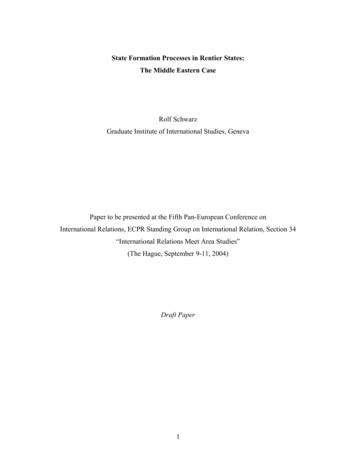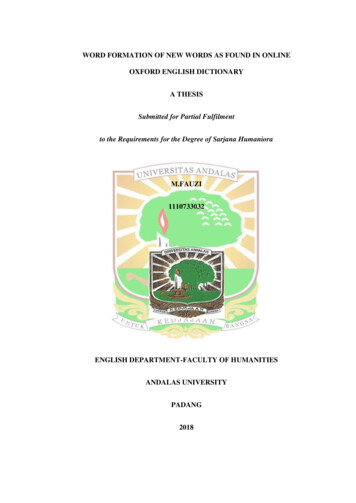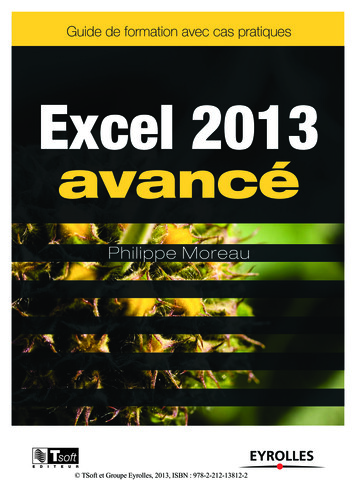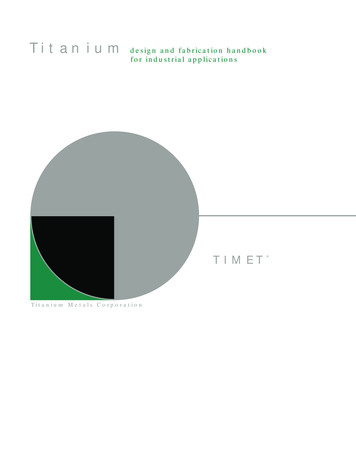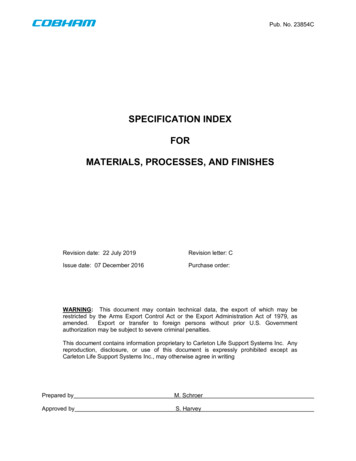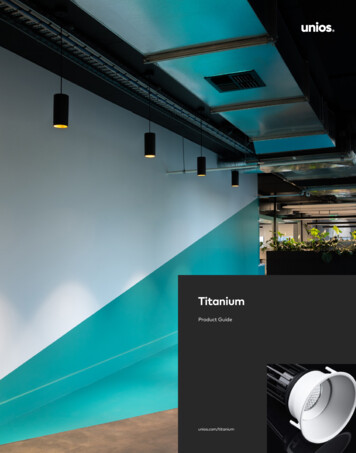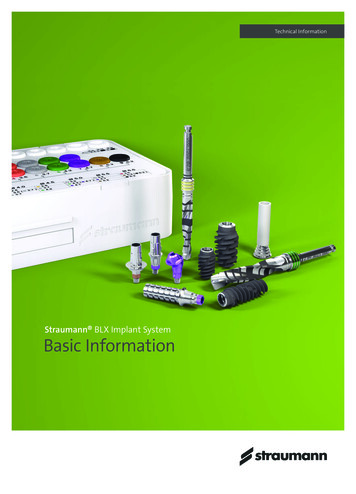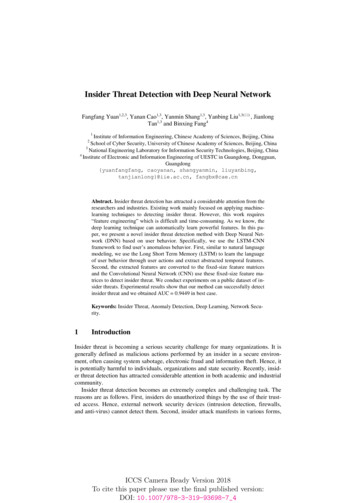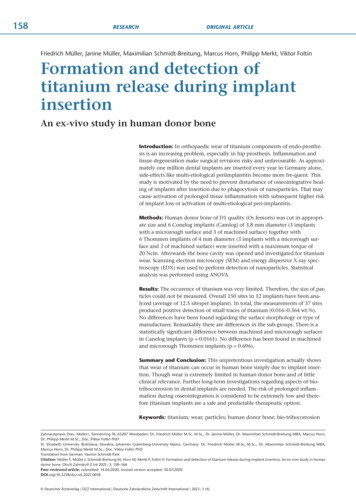
Transcription
158RESEARCHORIGINAL ARTICLEFriedrich Müller, Janine Müller, Maximilian Schmidt-Breitung, Marcus Horn, Philipp Merkt, Viktor FoltinFormation and detection oftitanium release during implantinsertionAn ex-vivo study in human donor boneIntroduction: In orthopaedic wear of titanium components of endo-prosthesis is an increasing problem, especially in hip prosthesis. Inflammation andtissue degeneration make surgical revisions risky and unfavourable. As approximately one million dental implants are inserted every year in Germany alone,side-effects like multi-etiological periimplantitis become more fre-quent. Thisstudy is motivated by the need to prevent disturbance of osseointegrative healing of implants after insertion due to phagocytosis of nanoparticles. That maycause activation of prolonged tissue inflammation with subsequent higher riskof implant loss or activation of multi-etiological peri-implantitis.Methods: Human donor bone of D1 quality (Os femoris) was cut in appropriate size and 6 Conelog implants (Camlog) of 3,8 mm diameter (3 implantswith a microrough surface and 3 of machined surface) together with6 Thommen implants of 4 mm diameter (3 implants with a microrough surface and 3 of machined surface) were inserted with a maximum torque of20 Ncm. Afterwards the bone cavity was opened and investigated for titaniumwear. Scanning electron microscopy (SEM) and energy dispersive X-ray spectroscopy (EDX) was used to perform detection of nanoparticles. Statisticalanalysis was performed using ANOVA.Results: The occurence of titanium was very limited. Therefore, the size of particles could not be measured. Overall 150 sites in 12 implants have been analyzed (average of 12.5 sitesper implant). In total, the measurements of 37 sitesproduced positive detection of small traces of titanium (0.016–0.364 wt.%).No differences have been found regarding the surface morphology or type ofmanufacturer. Remarkably there are differences in the sub-groups. There is astatistically significant difference between machined and microrough surfacesin Canelog implants (p 0.0161). No difference has been found in machinedand microrough Thommen implants (p 0.696).Summary and Conclusion: This unpretentious investigation actually showsthat wear of titanium can occur in human bone simply due to implant insertion. Though wear is extremely limited in human donor bone and of littleclinical relevance. Further long-term investigations regarding aspects of biotribocorrosion in dental implants are needed. The risk of prolonged inflammation during osseointegration is considered to be extremely low and therefore titanium implants are a safe and predictable therapeutic option.Keywords: titanium; wear; particles; human donor bone; bio-tribocorrosionZahnarztpraxis Dres. Müller , Tannenring 76, 65207 Wiesbaden: Dr. Friedrich Müller M.Sc. M.Sc., Dr. Janine Müller, Dr. Maximilian Schmidt-Breitung MBA, Marcus Horn,Dr. Philipp Merkt M.Sc., Doc. Viktor Foltin PhDSt. Elisabeth University Bratislava, Slovakia; Johannes Gutenberg-University Mainz, Germany: Dr. Friedrich Müller M.Sc. M.Sc., Dr. Maximilian Schmidt-Breitung MBA,Marcus Horn, Dr. Philipp Merkt M.Sc., Doc. Viktor Foltin PhDTranslation from German: Yasmin Schmidt-ParkCitation: Müller F, Müller J, Schmidt-Breitung M, Horn M, Merkt P, Foltin V: Formation and detection of titanium release during implant insertion. An ex-vivo study in humandonor bone. Dtsch Zahnärztl Z Int 2021; 3: 158–166Peer-reviewed article: submitted: 14.04.2020, revised version accepted: 30.07.2020DOI.org/10.3238/dzz-int.2021.0018 Deutscher Ärzteverlag DZZ International Deutsche Zahnärztliche Zeitschrift International 2021; 3 (4)
MÜLLER F, MÜLLER J, SCHMIDT-BREITUNG ET AL.:Formation and detection of titanium release during implant insertionIntroductionThis study investigates wear of dentaltitanium implants after insertion inhuman donor bone of D1 quality.Wear particles can be phagozytosedby macrophages and therefore promote prolonged inflammation andcompromise osseointegration. Nanoparticles are ubiquitous in our dailylife and can be found in dental materials, too. Schmalz et al. were working on an overview of nanoparticlesin dentistry [36, 37]. They found thatnanoparticles can be producedthrough wear of restorative materials(e.g. ceramics, metals) or can be released from dental implants and thatthey might be able to enter the biological environment when restorations or implants are being removedfrom the oral cavity.A recently published review oncorrosion and wear of titanium-baseddental implant connections showedthat the problem of nanoparticlesreached scientific evidence [2]. Thisscoping review of Apaza-Bedoya et al.showed that degradation at the implant-abutment connection due towear and tribological processes areamong the serious problems in dentistry. They stated that wear and corrosion debris (e.g. ions and microand nanoparticles) that are releasedinto the biological surrounding tissuecan stimulate peri-implantitis that inturn leads to pathologic bone resorption.A review of the literature of titanium toxicity by Kim et al. revealedseveral toxic and allergic reactionsFigure 1 Deep frozen human femur shaftFigure 2 Human femur shaft with inserted implantsFigure 3 Canelog Implants machined (above) and microrough surface (below) Deutscher Ärzteverlag DZZ International Deutsche Zahnärztliche Zeitschrift International 2021; 3 (4)159
160MÜLLER F, MÜLLER J, SCHMIDT-BREITUNG ET AL.:Formation and detection of titanium release during implant insertionFigure 4 Thommen Implants machined (above) and microrough surface (below)[18]. The most used titanium material is TiO2 powder that can be foundin various applications such aspaints, food products, drugs and cosmetics [ 9, 42] followed by increasingconcerns of its influence on our environment and human health [3,13,54]. Toxicity of TiO2 nanoparticles inrodents has been shown in manystudies [5, 6, 8, 11, 14, 41, 48, 50, 51,57].Although titanium and its alloysare the most biocompatible material,wear and corrosion can still occur inextreme environment and conditions(e.g. low pH and high concentrationsof fluoride) [19, 29, 44]. Schiff et al.found that fluorine ions can even de-stroy the titanium passive layer [35].Wachi et al. found that titaniumions might be responsible for deteriorating effects of peri-implant mucositis [49]. Olmedo et al. found macrophages loaded with titanium particlesas an indicator of corrosion processesof failed implants in human peri-implant soft tissue [27]. Using the exfoliative cytological test to observeparticles inside and outside of epithelial cells and macrophages, studiesfrom Olmedo and Penmetsa foundsignificant higher rates of implantparticles in patients with peri-implantitis [28, 30]. Wilson et al. discussed three possibilities that cancause presence of titanium particles:releasing due to friction between implant and bone during insertion,wear during debridement at maintenance procedures, and corrosion [53].The damage of the surface of the implant due to particle release duringinsertion was observed by Senna etal. [40]. On the other hand Addisonet al. proposed localized surface corrosion and micro-motions to be responsible for titanium particles andfound wear debris unlikely to be themajor contributor of particles [1].Own investigations regardingtorque dependent insertion depth ofdental titanium implants in artificialbone showed that implants arestressed during insertion with up to70 Ncm of torque [24]. Wear of dental titanium implants in artificialbone was subsequently investigated[25]. It has been shown that in artificial bone of D1 quality wear was verylimited with only 0.17 to 0.47 atomicpercent and with particles of 100 to150 nm in size. This present studywas aimed to re-check the previousfindings under more clinically relevant conditions in human donorbone of D1 quality.MethodsFigure 5 EDX-spectrum of sample 7 Deutscher Ärzteverlag DZZ International Deutsche Zahnärztliche Zeitschrift International 2021; 3 (4)Human donor bone was provided bythe Dr. Senckenberg Anatomical Institute of the University Hospital ofthe Goethe University Frankfurt (No.65300308–2018–01). The donor boneencompassed a deep frozen femurbone shaft (Os femoris) of 25 cm inlength and 3.5 cm in width (Fig. 1).
MÜLLER F, MÜLLER J, SCHMIDT-BREITUNG ET AL.:161Formation and detection of titanium release during implant insertionThe shaft was split longitudinally andafterwards fixated by screws crossways. By this, the bone cavity couldbe opened after implant setting without bringing stress to the implantsurface or the cavity walls (Fig. 2).Afterwards implants have been inserted into the cut of the lengthwiseseparation. Due to the restrictedlength of the bone shaft the limitednumber of only 12 implants could beinserted with sufficient space between the implants. This fact enabledthe placement of only 3 implants ofeach group. Six Conelog implants(Camlog) of 3,8 mm diameter (3 implants with microrough surface and 3with machined surface) together with6 Thommen implants of 4 mm diameter (3 implants with microrough surface and 3 with machined surface)were inserted with a maximumtorque of 20 Ncm and sufficientwater cooling to prevent heat exhaustion. In both systems standard stainless steel drills were used meeting therecommendations of the drillingprotocols. A previous analysis of anunused stainless steel drill for possible titanium sources showed a veryhomogeneous composition of thedrill surface. The spectra gave a slightindication of the presence of titanium on the drill surface, but the titanium signal of the EDX analysiswas not greater than its statisticalerror. Therefore, titanium was onlypresent in traces in the drill material.To obtain sample size small enoughfor the SEM vacuum chamber eachimplant cavity was cut into 1.5 cmpieces (Fig. 3 and 4). Implant andbone units have been dried in an exsiccator for 14 days to ensure SEMimaging. To obtain suitable electricalconductivity of the donor bone, sputtering of these samples was necessary.The device used was Edwards S150BSputter Coater. Sputter gas was Argonto provide a suitable source of ionsfor efficient target bombardment.Target material was gold (negativecathode) having favourable electricalconduction features. Samples havebeen sputtered for one minute at 1kVvoltage and 100 mbar pressure. Additional advantages of sputtering wasreduction of scanning electronmicroscope beam damage to thebone, reduction of sample charging,SampleDescriptionSites persampleMean (Tiunit wt.%)SDminmax1Canelogosseointegrative20(4 ive12(4 ive16(1 positive)0.0330.0240.0000.0974Canelogmachined6(0 positive)0.0140.0100.0030.0295Canelogmachined4(2 positive)0.0210.0230.0050.0556Canelogmachined2(0 ive15(6 ive15(5 ive15(2 positive)0.0290.0190.0000.05910Thommenmachined15(6 positive)0.0370.0160.0040.06411Thommenmachined15(3 positive)0.0740.0640.0000.25212Thommenmachined15(4 positive)0.0290.0180.0020.060Table 1 Detection of traces of titanium on Canelog and Thommen implants (unitweight %)improvement of secondary electronemission as well as improvement ofedge resolution. Energy dispersiveX-ray spectroscopy (EDX) is ameasurement method in the field ofmaterial testing and analytics. Theelectron beam of specific energy isused to stimulate atoms of a certainsample that thereupon emit a characteristic X-ray radiation. Each element emits its specific and distinctX-ray spectrum. In this way the elementary composition of the samplessurface can be analyzed. Statisticalanalysis was performed using oneand two-factor analysis of variance(ANOVA).The output of the EDX-softwareof a concentration value of a specificelement cannot be mistaken with apositive detection of the analyzed el-ement even if the nominal value isnon-zero. In fact the interpretation ofthe value is based on statistical tests.That means that with a certain probability the real and unknown resultof titanium is located around thegiven value. For this reason the software also shows the standard deviation (SD) in addition to themeasured nominal count. If onechooses the single standard deviationthe probability that the real and unknown value of titanium lies withinthe standard deviation is 68.3 %. Ifone doubles the standard deviation(2SD) the probability raises to 95.5 %.Nominal values less than the singleor double standard deviation indicatea corresponding high probability thatthe real and unknown titanium valueis zero (even the value itself is not Deutscher Ärzteverlag DZZ International Deutsche Zahnärztliche Zeitschrift International 2021; 3 (4)
MÜLLER F, MÜLLER J, SCHMIDT-BREITUNG ET AL.:162(Fig. 1–6, Tab. 1: F. Müller)Formation and detection of titanium release during implant insertionFigure 6 Box-Plotzero). Actually in analytical practicethis in turn means that titaniumcould not be detected seriously.ResultsIn total 12 implants were insertedinto human donor bone, 6 Conelogimplants and 6 Thommen implantsof which 3 of each manufacturerhave had a microrough osseointegrative surface and 3 of each group amachined surface. SEM investigationand EDX analyses have been performed on various sites of the crestalparts of each implant. Overall150 sites in 12 implants have beenanalyzed (average of 12.5 sites perimplant). In total the measurementsof 37 sites (24.55 %) produced positive detection of little traces of titanium (0.016–0.364 wt.%).Canelog implants with microrough surface produced 9 of 48 positive sites (18.75 % of 48 sites) andCanelog machined surface implantsproduced 2 of 12 positive sites(16.66 % of 12 sites). Thommen implants with microrough and machined surface produced 13 of 45positive sites each (28.88 % of45 sites) (Tab. 1 and Fig. 5).Univariate statistical analysesshowed no differences regardingthe surface morphology (p 0.326)or type of implant manufacturer(p 0.167). Bivariate testing including both factors (surface andmanufacturer) showed a marginalsignificant difference (p 0.0755) indicating that there are differences inthe sub-groups. There is a statisticallysignificant difference between machined and microrough surface inCanelog implants (p 0.0161) as wellas a difference between machinedsurface implants of Thommen andCanelog (p 0.0826). No differencehas been found in machined andmicrorough Thommen implants(p 0.696). Also no statistical significant difference has been found between microrough surface implantsof Thommen and Camlog (p 0.81)(Fig. 6).DiscussionThis present study indicates that theinvestigated titanium implants areonly very little abrasive. The most abrasive resistant surface was found inCanelog implants with machinedsurfaces. Nearly similar abrasive behavior was found in both Thommensurfaces together with microroughCanelog implants. Results of a previously published investigation ofCanelog implants have shown a tentimes higher abrasion behavior inartificial bone compared to humandonor bone (up to 0.46 wt.% of tita- Deutscher Ärzteverlag DZZ International Deutsche Zahnärztliche Zeitschrift International 2021; 3 (4)nium particles) [25]. This differencemight be determined due to theproperties of the artificial boneblocks (Sawbone, 40 pcf) that wereused previously. These solid blockswere completely of compacta bonequality while human donor bone wasof spongious medullary consistencyin the center of the sample with anouter rim of compacta structure ofonly 2–3 mm. This compacta structure was found to be strong enoughto obtain primary stability for all implants but lacks standardization (Fig.7). On the one hand this standardization was given sufficiently in theartificial bone model that was lackingclinical needs on the other hand. Theresults show that microrough surfaces are more abrasive than machined surfaces due to the micro-retentive pattern after sand blastingand acid etching to ensure osseointegration. Therefore, it is no wonderthat Canelog’s machined surface isclearly less abrasive than its microrough. Remarkably this differencecannot be found in Thommen’s surface where machined is comparableabrasive to microrough. Another interesting fact is that both Canelogand Thommen microrough surfacesare similar in abrasive behavior. Sono superiority of one manufacturerover the other can be concluded.In comparison Sridhar et al. didnot found traces of titanium of16 Straumann implants in artificialbone of 10, 20, 30 and 40 pcf Sawbone blocks [43]. The examinationmethod used by Sridhar et al. (lightmicroscopy and X-ray diffractometry)can be regarded as a potential causefor the failure to successfully detecttitanium nanoparticles, since lightmicroscopy does not achieve magnifications as high as those with ascanning electron microscope andtherefore titanium particles that arescattered cannot be reliably detectedin the nanometer range. In contrastanother in-vitro study found reducedoxide layer of dental implants afterinsertion and pullout tests usingmicrostructural analysis [47]. Deppeet al. found that the mean surfaceroughness, mean maximal roughnessand the developed surface area ratiowere highly modified after implantplacement into bone using an in-
MÜLLER F, MÜLLER J, SCHMIDT-BREITUNG ET AL.:163vitro study model [10]. Three different implant systems with differentsurface roughness have been insertedinto Class I porcine bone. It wasfound that in the acid-etched implant surface the mean surface roughness decreased especially in the apicalregion (-10.4 %) compared to largegrit-blasted implant surface. In anodized implants the mean surfaceroughness increased ( 5.7 %) indicating a destruction of the surface.Meyer et al. confirmed contamination of peri-implant bone in minipigs after placement of titanium implants by using scanning electronmicroscopy [20]. Results revealed titanium particles especially in the crestal part of the bone and around implants with rough surfaces. Wear wasfound to be less important on surfaces with a roughness of 1.5 µm and0.4 µm. Recently, these findings havebeen confirmed by Suarez-Lopez delAmo et al. [45]. The authors tested5 different implant surfaces (dualacid etched, fluoride-modified, sandblasted large-grit acid-etched/hydrophilic sandblasted large-grit acidetched, phosphate-enriched titaniumoxide, and large grit). Results showedround or small angular elongated titanium debris in the crestal part ofthe osteotomy site. In contrast thesefindings could not have been confirmed by another group of researchers [52]. After insertion of implants in rabbit tibia Wennerberg etal. did not find an association between implant roughness and ion release. Surgical interventions of advanced peri-implantitis often requirethe removement of macroscopic implant threads for surface smoothening [39]. Various instruments havebeen tested to achieve a new plainimplant surface [7, 32]. Schwarz et al.clearly demonstrated titanium contamination of neighboring bone andconnective tissue after this implantoplasty resulting in a localized mixedchronic inflammatory cell infiltratedominated by plasma cells and lymphocytes [38]. Actually, the authorsdid not report any clinical adverse effects related to the presence of thosetitanium particles. Peri-implantitistreatment in all its aspects is yetinsufficiently predictable [16] compared(Fig. 7: Dr. Manuel Niederhagen, OptiPath Frankfurt/M.)Formation and detection of titanium release during implant insertionFigure 7 Histological verification of compactato periodontitis treatment [22] andtherefore scientific evidence is heterogeneous [23]. That’s why knowledge of every part of the etiologyof peri-implantitis is mandatory. Acontrary assessment was recentlydone by Petterson at al. [31]. In orderto investigate the influence of titanium on peri-implant inflammation,13 patients with peri-implantitis (testgroup) and 11 patients with periodontitis (control group) have beenincluded in this study. In patientswith peri-implantitis, significantlyhigher titanium values have beenmeasured than in the control group.They concluded that titanium canpotentially worsen inflammationsymptoms and make treatment prognosis worse. In order to investigatethe possible influence of releasedcomponents of dental implants as aresult of peri-implant therapy or thecorrosion of the titanium surface,Noronha Oliveira et al. carried out asystematic literature search in thePubmed database [26]. 79 articleshave been included in the analysis. Ithas been observed that metal ionsand metal particles activate osteoclasts, pro-inflammatory cells and cytokines in the peri-implant tissues.Degenerative changes have beenfound in macrophages and neutrophils after the phagocytosis of titanium microparticles. Degradationproducts that result from the degradation of dental implants have a cytotoxic and genotoxic potential forperi-implant tissues. The quantityand the physicochemical propertiesof the degradation products determine the extent and damage to theperi-implant tissues. Safioti et al. performed a cross-sectional study onperi-implantitis and bacterial load[34]. They believe that in peri-implantitis bacteria not only trigger animmune response from the host, butalso lead to electrochemical changesand corrosion of the titanium surface, which can result in an increasedinflammatory process. In order to investigate the influence of the releasedtitanium on the peri-implant inflammation, 20 plaque samples of 30 patients have been taken and analyzed.Significantly higher titanium valueshave been measured in implants withperi-implantitis than in healthy periimplant conditions.Investigations on orthopedicprosthesis revealed the underlyingpatho-physiologic mechanism resulting in bone and implant loss [12, 15].Titanium alloy increases the releaseof inflammation-inducing mediators(Prostaglandin E2, Interleukin-1, Interleukin-6, TNF) [15]. Human monocytes released more inflammatorymediators due to Ti-Al-V in comparison to titanium-aluminum-niobium Deutscher Ärzteverlag DZZ International Deutsche Zahnärztliche Zeitschrift International 2021; 3 (4)
164MÜLLER F, MÜLLER J, SCHMIDT-BREITUNG ET AL.:Formation and detection of titanium release during implant insertion(Ti-Al-Nb) [33]. Yu et al. investigatedsynergistic effects of H2O2 and albumin on corrosion behavior of titanium alloy (Ti6Al4V) in physiologicalsaline [56]. A much higher rate ofmetal release was observed in bothmedia (albumin and H2O2) comparedto the presence of H2O2 and albuminalone. Furthermore Zhang et al.showed that albumin suppressedthe dissolution of Ti6Al4V in thepresence of H2O2 at short periods( 24 h), but after longer periods thedissolution rate increased. Thatmight be attributed to the reductionof the oxide film of titanium [58].Allergic reactions against titanium are supposed to be impossibleand mostly intolerance or hypersensitive reactions against titanium arewrongly diagnosed as allergy. Thereare reports of hypersensitive reactions like erythema, eczema, pain,necrosis and bone loss after insertionof titanium implants [18] but allergicreactions were reported by Hosoki etal. in 2016 [17] and Thomas et al.[46]. Berglund and Carlmark performed a study on systemic disease oftitanium (known as “yellow nailsyndrome”) using energy-dispersiveX-ray fluorescence (EDXRF) in thenails of 30 patients and found highconcentrations of titanium [4].A recently published comprehensive critical review concluded that titanium particles are being releasedfrom titanium surfaces because ofmechanical wear, contact to chemicalagents, and interaction with substances produced by adherent biofilmand inflammatory cells [21]. Theauthors found that wear, corrosion,titanium particles, inflammation,and microorganisms take part in acomplex host response to foreignbodies. Environmental factors together with corrosion and wear leadto material degradation called tribocorrosion. Released titanium particlesdisturb cell function, surface disruption changes protein absorption,bacterial load causes inflammation,inflammation changes pH that inturn alters the composition of biofilms that in turn causes again corrosion. So multiple feedback loopscompromise the peri-implant hardand soft tissue. Mombelli et al. finallyconcluded nicely that “biofilms causeinflammation, and biofilms causecorrosion”. In summary this conclusion can be broadened to the fullaspect of the scientific field of bio-tribocorrosion “insertion causes wear,wear causes inflammation, wearcauses corrosion, corrosion causeswear, corrosion causes inflammation,inflammation causes corrosion, biofilms cause inflammation, biofilmscause corrosion” [55].Nevertheless, the fact that implant insertion causes very limitedwear as shown is only a small aspectin the etiology of multifactorial periimplantitis and its clinical relevancecompared to bacterial issues and immune response might be inferior. Stillclinicians should keep this aspect inmind to promote and augment adequate options for their patients during primary (implant insertion) andsecondary (peri-implantitis treatment) implant surgery.AcknowledgementThe present study was financiallysupported by DGZMK scientific funds(15.000 Euro), the Oral Reconstruction Foundation (3.080 Euro) andThommen (2.260 Euro). Thanks go toDr. Christian Hof and Dr. HendrikReers for their help with realizationof this study and evaluation of thedata.Conflicts of interestThe authors declare that there is noconflict of interest as defined by theguidelines of the International Committee of Medical Journal Editors.References1. Addison O, Davenport AJ, NewportRJ et al.: Do ‘passive’ medical titaniumsurfaces deteriorate in service in the absence of wear? J R Soc Interface 2012; 9:3161–31642. Apaza-Bedoya K, Tarce M, BenfattiCAM et al.: Synergistic interactions between corrosion and wear at titaniumbased dental implant connections: Ascoping review. J Periodont Res 2017; 52:946–9543. Batt J, Milward M, Chapple I, GrantM, Roberts H, Addison O: TiO 2 nanopar- Deutscher Ärzteverlag DZZ International Deutsche Zahnärztliche Zeitschrift International 2021; 3 (4)ticles can selectively bind CXCL8 impacting on neutrophil chemotaxis. Eur CellMater 2018; 35: 13–244. Berglund F, Carlmark B: Titanium,sinusitis, and the yellow nail syndrome.Biol Trace Elem Res 2011; 143: 1–75. Bermudez E, Mangum JB, AsgharianB et al.: Long-term pulmonary responsesof three laboratory rodent species to subchronic inhalation of pigmentary titanium dioxide particles. ToxicologicalSciences 2002; 70: 86–976. Bermude E, Mangum JB, Wong BAet al.: Pulmonary responses of mice, rats,and hamsters to subchronic inhalation ofultrafine titanium dioxide particles. Toxicological Sciences 2004; 77: 347–3577. Bollen CM, Papaioanno W, VanEldere J, Schepers E, Quirynen M, VanSteenberghe D: The influence of abutment surface roughness on plaque accumulation and peri-implant mucositis.Clin Oral Implants Res 1996; 7: 201–2118. Chen J, Dong X, Zhao J, Tang G: Invivo acute toxicity of titanium dioxidenanoparticles to mice after intraperitoneal injection. J Appl Toxicol 2009; 29:330–3379. Chen XX, Cheng B, Yang YX et al.:Characterization and preliminary toxicityassay of nano-titanium dioxide additivein sugar-coated chewing gum. Small2013; 9: 1765–177410. Deppe H, Wolff C, Bauer F, Ruthenberg R, Sculean A, Mücke T: Dental implant surfaces after insertion in bone: anin vitro study in four commercial implantsystems. Clin Oral Investig 2018; 22:1593–160011. Fabian E, Landsiedel R, Ma-Hock L,Wiench K, Wohlleben W, Van Ravenzwaay B: Tissue distribution and toxicity ofintravenously administered titanium dioxide nanoparticles in rats. Arch Toxicol2008; 82: 151–15712. Furrer S, Scherer Hofmeier K, Grize L,Bircher AJ: Metal hypersensitivity in patients with orthopaedic implant complications – a retrospective clinical study.Contact dermatitis 2018; 79: 91–9813. Grande F, Tucci P: Titanium dioxidenanoparticles: a risk for human health?Mini Reviews in Medicinal Chemistry2016; 16: 762–76914. Hamilton RF, Wu N, Porter D, BufordM, Wolfarth M, Holian A: Particle lengthdependent titanium dioxide nanomaterials toxicity and bioactivity. Particle andFibre Toxicology 2009; 6: 3515. Haynes DR, Rogers SD, Hay S, PearcyMJ, Howie DW: The differences in toxicityand release of bone-resorbing mediators.J Bone Joint Surg Am 1993; 75: 825–83416. Hoffmann T, Müller J, Gehrke P,Müller F: Antimicrobial photodynamic
MÜLLER F, MÜLLER J, SCHMIDT-BREITUNG ET AL.:165Formation and detection of titanium release during implant insertiontherapy in peri-implantitis treatment – asystematic review. Int Poster J Dent OralMed 2015; 17: No. 4, Poster 92917. Hosoki M, Nishigawa K, Miyamoto Y,Ohe G, Matsuka Y: Allergic contact dermatitis caused by titanium screws anddental implants. J Prosthodont Res 2016;60: 213–21918. Kim TK, Eo MY, Nguyen TTH, KimSM: General review of titanium toxicity.Int J Implant Dent 20219; 5: 1019. Martini D, Fini M, Franchi M et al.:Detachment of titanium and fluorohydroxyapatite particles in unloaded endosseous implants. Biomaterials 2003; 24:1309–131620. Meye U, Bühner M, Büchter A, KruseLösler B, Stamm T, Wiesmann HP: Fast element mapping of titanium wear aroundimplants of different surface structures.Clin Oral implants Res 2006; 17:206–21121. Mombelli A, Hashim D, Cionca N:What is the impact of titanium particlesand biocorrosion on implant survival andcomplications? A critical review. Clin Oralimplants Res 2018; 29: 37–5322. Müller F, Müller J, Noack B, Hoffmann T: Adjunctive antimicrobialphotodynamic therapy in chronic periodontitis treatment – a meta-analysis. IntPoster J Dent Oral Med 2015; 17: No. 4,Poster 93323. Müller F: Comparison of clinical evidence of antimicrobial photodynamictherapy in periodontitis and peri-implantitis treatment. Int Poster J Dent OralMed 2016; 18: No. 2, Poster
ate size and 6 Conelog implants (Camlog) of 3,8 mm diameter (3 implants with a microrough surface and 3 of machined surface) together with 6 Thommen implants of 4 mm diameter (3 implants with a microrough sur-face and 3 of machined surface) were inserted with a maximum torque of 20 Ncm. Afterwards the bone cavity was opened and investigated for .
